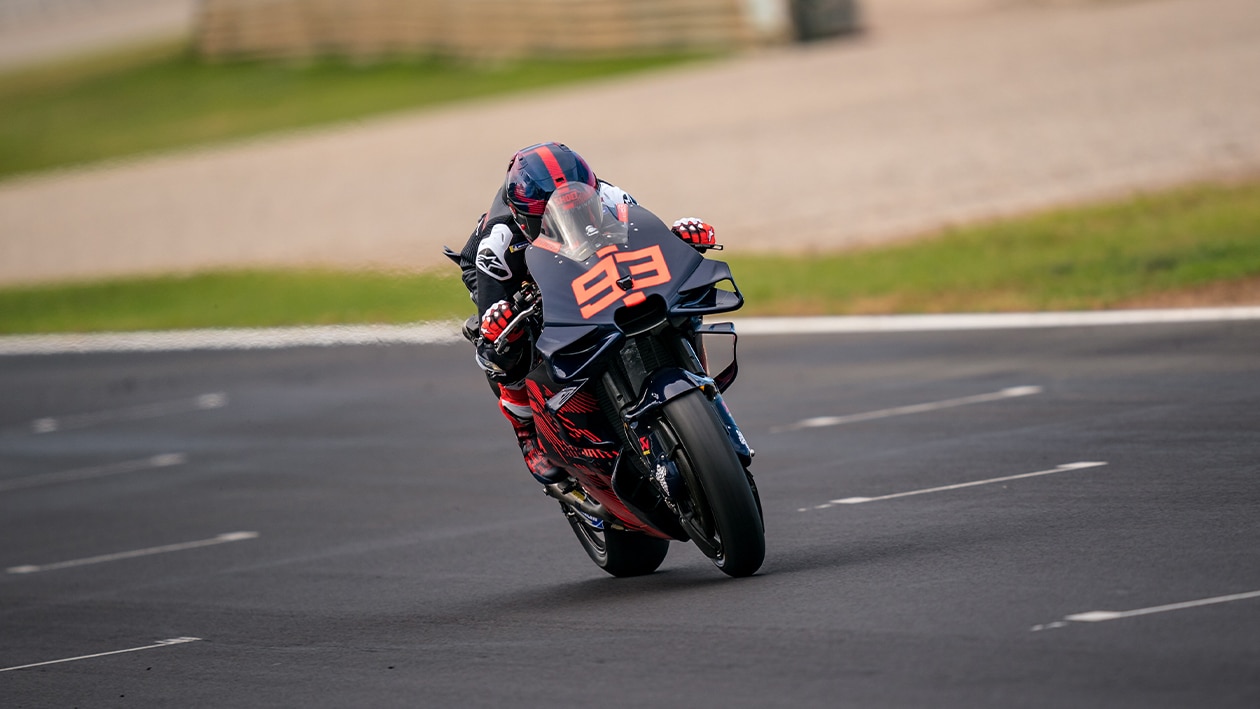Mat Oxley: ‘Márquez on a Ducati? It will be an awesome combination in 2024’
‘After 42 laps on a Ducati, Marc Márquez was the fastest man on track’

Márquez begins his Ducati career at the post-season test
Steve Wobser/Getty Images
Many MotoGP fans were dubious about Marc Márquez’s switch from factory Honda rider to independent-team Ducati rider for 2024. The six-times MotoGP king hadn’t won the title since 2019, struggling through the last four seasons with a right-arm injury sustained at the start of the 2020 MotoGP championship. He’s past his best, said the doubters.
Four operations followed, including a humeral osteotomy, which involved surgeons cutting the humerus in two, rotating the lower part 30 degrees and plating it back together.
Surely Márquez was done? Surely even his fiery determination would be quenched by something as gruesome as that?
And yet no one in the MotoGP paddock had any doubts. Those in the know don’t judge riders entirely by results. They see the struggles they’re going through – on and off their motorcycles – and see beyond the results.
Márquez won six titles with Honda in seven seasons, even though the company’s RC213V was never the best bike on the grid. That’s why he was always a sight to behold – pushing like hell, flirting with disaster at every corner, overriding the bike to get the results he wanted. In fact, the results he needed. Márquez lives for crushing his rivals.
That spectacular modus operandi ceased to be enough during the last few seasons, due to the vast strides made by Ducati and MotoGP’s other European manufacturers, who have transformed the championship with new-wave technology inspired by Formula 1: downforce aerodynamics, tuned mass dampers and ride-height adjusters.
During the 2023 MotoGP season Márquez crashed more than ever – 29 tumbles during the 20-round season, essentially because he was racing a bike against two-wheeled F1 cars.
Thus the sense of anticipation when he climbed aboard a Gresini Ducati Desmosedici for the first time during November’s first post-season tests was immense.
In cool, tricky conditions at Valencia it took the 30-year-old Spaniard just 42 laps to be the fastest man on track. He ended the day fourth quickest, 0.17sec off the top, with a lap time 0.15sec slower than the best qualifying lap he had managed with his RC213V at the previous weekend’s season finale at the track. And he looked like he was hardly trying – his bull-in-a-china-shop antics already a thing of the past.
The Ducati is a longer, lower motorcycle, which makes it easier to control. The marque’s current number one, Pecco Bagnaia – winner of the 2022 and 2023 MotoGP crowns – says the bike’s most important feature is its rider-friendliness: “The best thing is the smoothness you feel, everywhere.”
During the Valencia tests Márquez looked like he was sat in a comfy armchair, not perched on a razor blade. His riding had a smooth flow to it, which means two things: the Ducati works best that way and he’s already worked that out. Márquez will be one of eight Ducati riders on the 2024 grid and he won’t even have the latest machinery – that’s how much he wanted to leave Honda, which has had a disastrous last few seasons, its engineers discombobulated by the sudden advance of the Europeans.
“He looked like he was sat on a sofa, rather than a razor blade”
Bagnaia and Jorge Martin, the Italian’s strongest rival last season, and two others will ride GP24s this season, while Márquez and three others will race second-hand GP23s. The differences between the two machines will be small. Off-season testing is so limited that Ducati understands big changes are risky. Computer simulations are less accurate in MotoGP than F1, so track time is everything and it’s easy for engineers to find themselves heading down the wrong road if they try anything too radical.
When news of Márquez’s defection first broke, Ducati’s other riders greeted the news with delight, not dismay. (At least in public.) Ducati has a policy of full data sharing between its riders, so they can all spy on each other when they return to the garage after each run. At Valencia they all noticed that he was already the fastest Ducati rider through Turn Eight.
And the next day he took himself off to hospital for more surgery, to cure an arm-pump problem in his right arm. This was one reason why he didn’t do many laps during the Valencia tests. The other was to save tyres.
Ducati has been so successful in recent years – winning the last two riders’ titles and the last four constructors’ crowns – that Ducati riders get a third fewer tyres for testing than those of the least successful manufacturers, Yamaha and Honda, which finished fourth and fifth in the 2023 constructors’ points, behind Ducati, KTM and Aprilia.
Beyond his spellbinding talent and Senna-like aggression, Márquez’s strongest feature is his intelligence: why waste tyres at chilly Valencia when you can save them for February’s testing at Sepang, Malaysia, and Losail in Qatar.
Márquez and a Ducati will be an awesome combination. Even more so with his new crew chief Frankie Carchedie, the British engineer who guided Joan Mir to the 2020 MotoGP title and last season transformed Fabio Di Giannantonio from also-ran to MotoGP winner. Carchedie is hugely experienced, very bright and very good with the human part of motorcycle racing, which is so important. Funnily enough, when he first started working with Gresini Ducati at the end of 2022 he told me, “If Márquez ever gets on one of these things, no one will see which way he went”.
Mat Oxley has covered motorcycle racing for many years – and also has the distinction of being an Isle of Man TT winner
Follow Mat on Twitter @matoxley
